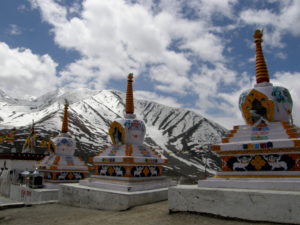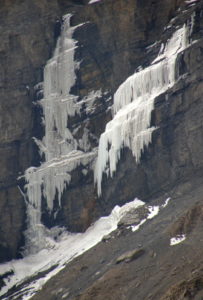Into the Clouds of the Upper Himalayas
A travel and photo documentation by a rider to the cold desert of the Upper Himalayas of the Spiti Region of India.
The Transcendental Nature of Kyato on the Spiti River

W ords fail to describe the rugged beauty of the Spiti Region of the Himalayas. When we reached Kyato, after crossing the deep gorge of Chicham from Kibber, I ran into a herd of grazing yaks, who were quite inquisitive of my presence just as I was of theirs. In my earlier rides to Ladakh, I came across wild yaks on the Mori Plains but these creatures were out in the distance grazing on the scanty green, quite oblivious to my presence. But here atop the Kyoto heights, these benighted Himalayan bovines were close enough for my nostrils to reject their stench. As horribly as they stank, in equal measure, did they look graceful and mighty, effortlessly climbing the slopes to reach for tender blades. In fact, I quite expected to see a yeti or two to add to my delight at having witnessed such an exotic menagerie so high up in the clouds.
While I rolled down from the Kyoto top, my eyes disbelievingly gaped at one of the most beautiful and otherworldly landscapes I have been in. My wife and I got a glimpse of a terrain so unusual that for a moment, I was convinced that my bike had morphed into a spaceship and had transported us to a distant planet in some other galaxy.
“The Spiti river gorge of Kyato is a sculpted wonder inspiring awe so reverential that the English language falls hopelessly inadequate in supplying us with adjectives to describe the feeling.”
Nature being the master artist has employed all its tools of chiseling in the form of water, wind, sun and snow to carve the alien world of Kyato.
Here one encounters inverted gigantic ice cream cones, sand slides that mimic the matted hair of Shiva, castle rampart type vertical sandy walls, frozen waterfalls, the crystal flow of a gentle giant called the benign Spiti and a small lake that sits atop this gorge below its snow capped guardians.

Our ride through this amazingly surreal place was accidental, for I had set out to reach the high Kunzum Pass through Rangrick but a good Samaritan, a local driver, advised me to avoid a 30 kilometre stretch of bad road and take this path instead. He told me that this is a new road that has come up after the completion of the Chicham Bridge and makes for a better travel. He told me nothing about the beauty of this place though. However, I fully understand this by recalling a common Bengali saying ‘one who lives near a railway station often misses the train’.
Ride to the Kunzum Pass and Lahaul Spiti district
My climb of the 4,590 metres (15060 feet) high Kunzum Pass started from the village of Losar in the Spiti region of the Lahaul and Spiti District of Himachal Pradesh. The climb and descent of the Kunzum is a gravel track that for most of the year remains snow covered. Due to its remoteness and the extremities of the climate here, the government is unable to build proper roads.
The Kunzum Pass is surrounded by tall mountain peaks and the Bara Sigri Glacier. The view of these white tops from the pass is unsurpassed. I have been across many high altitude passes in the Himalayas, especially in the Ladakh Region and I agree that all these passes are uniquely beautiful, but the Kunzum has a distinctive character of its own that is unmatched. It sits like an inverted bowl surrounded by white giants that are unimaginably beautiful. One more aspect that makes the Kunzum so alluring is that it is one of the least crossed passes in the Himalayas because it is nestled in one of the remotest areas of the Himalayan region.

The base of the Kunzum climb on the other side is called Batal. Here are two dhabas that people stop by for lunch and tea. On my asking the owner about the road condition from Batal to Gramphu, he casually said, “all this while, you have only seen the trailer but now, the movie is about to begin”, quoting actor Shah Rukh Khan’s famous dialogue from the movie, ‘Om Shanti Om’. In his reply, I could sense sarcasm but then there was no going back. A few kilometers from Batal, as I was navigating over fallen boulders at a snail’s pace, from behind came sounds of several bikes. All of those riders were known faces from the Unido MC Nagpur, a group which brings together Bullet riders from Central India. Inside, I sighed a breath of relief, for if here my ride were to suffer a breakdown my wife and I would be stranded in this freezing wilderness and who knows what would have unfolded thereafter.
“After one descends down the Kunzum, one encounters the worst roads ever to have been carved on the sides of the Himalayan cliffs. Travelling on the road that leads to Ladakh from Manali in comparison to the Kaza Gramphu stretch over the Kunzum, is like a child’s play.”

The Kunzum stretch till Gramphu is replete with deep and difficult water crossings coupled with the fear of shooting stones and landslides, due to loose gravel that clings enmass to the cliffs above one’s head. Out of the 25 odd water crossings, four in particular need mention. The first one is encountered en route the Chandratal lake, which is an offshoot of the Kunzum descent. This is a nasty one due to the depth of the water. The other three namely Chota Dhara (ironic), Bara Dhara (underestimated) and an unnamed waterfall (that furiously flows on the road for about 200 metres till it drops off the cliff side) are gigantic ones between Kunzum and Gramphu.
From Batal, over the worst roads on earth, I reached Chatru. There we decided to pitch a camp beside a dhaba and spend the night alongside the fast flowing Chenab instead of venturing any further. Water crossings get more dangerous towards the evening and are most pliant in the morning. With this logic, we spent a wonderful night camping under the stars at Chatru.
(The writer is an artist and an avid biker, who rides to unknown historical destinations in India. He can be reached on twitter @sabyasachi76
